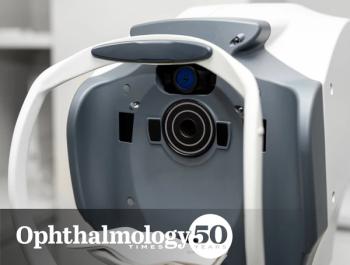
- Ophthalmology Times: July 15, 2021
- Volume 46
- Issue 12
Choroidal hypertransmission defects on en face OCT imaging predict geographic atrophy in patients
Philip Rosenfeld, MD, PhD, presents results from a natural history study of patients that results in recognition of hypertransmission defects on en face OCT.
Reviewed by Philip Rosenfeld, MD, PhD
The detection of choroidal hypertransmission defects on en face
This recognition of hypertransmission defects on en face OCT emerged from a natural history study of patients with large drusen who underwent imaging with Spectralis spectral-domain (SD) OCT (Heidelberg Engineering) and Cirrus SD-OCT (Carl Zeiss Meditec).
Related:
The averaged B-scans from the Spectralis were used to grade for nascent GA and the en-face Cirrus images were used to grade for the hypertransmission defects with a greatest linear dimension exceeding 125 μm.
These lesions were tracked for 36 months. If the lesions could be be detected for the entire 36 months, then they were considered persistent.
In this study,1 133 eyes of 68 patients imaged with both SD-OCT instruments were found to have 26 hyper-transmission defects in 19 eyes of 16 patients that fit the definition of persistence.
The average greatest linear dimension of these persistent lesions was 287 μm. When using a cut-off of either 250 or 300 μm, they found that both sizes showed a similar power to discriminate between persistent and transient lesions, Rosenfeld reported.
Lesions with a greatest linear dimension of 250 microns or greater correlated with nascent GA in 157 eyes of 81 patients and a significant association was found.1
Interestingly, he pointed out, that when there was discordance, such as when a hypertransmission defect was present without nascent GA, the hypertransmission defect was more likely to appear before the nascent GA.
Related:
Natural history study
“Based on our observations, we believe that hypertransmission defects are associated not only with nascent GA, but an even earlier stage of disease progression that eventually leads to GA. However, we needed proof that these defects led to GA,” he said.
Rosenfeld and his colleagues then conducted a natural history study to demonstrate the predictive power of hypertransmission defects.
Swept-source OCT was used to image 182 eyes of 131 patients with intermediate age-related macular degeneration with at least 1 large drusen and no evidence of GA.
The eyes were graded during follow-up for the appearance of persistent hypertransmission defects, GA, and nonexudative and exudative macular neovascularization.
At baseline, 29 eyes had a hyper-transmission defect of at least 250 μm and 32 eyes developed a hyper-transmission defect during follow-up.
Related:
“All 61 eyes showed persistence or disease progression; 17 eyes developed GA and 1 eye developed GA without a prior hypertransmission defect, but this could be explained by the lack of follow-up visits for 9 months due to an illness,” he reported.
When determining the time to the development of GA in all eyes, Rosenfeld found that at 36 months, 14% of eyes with drusen developed GA from baseline.
In the eyes with hypertransmission defects, at 36 months, 48% of eyes developed GA, which represented a 40-fold increased risk of formation of GA.
In this study, the presence of persistent hypertransmission defects indicated a higher risk of progression to GA.
En face imaging was advantageous for early detection of hyper-transmission images, and the technology provided much easier grading than averaged B scans.
Related:
Rosenfeld stated that the same volumetric scan used to measure these hypertransmission defects can also be used to measure the drusen area and volume, choriocapillaris flow defects, formation of macular neovascularization, and changes in choroidal vascularity.
An automated algorithm has been developed to detect these hypertransmission defects.
“Most consensus grading is done on highly averaged B scans. En face imaging facilitates early detection of hypertransmission defects," Rosenfeld concluded. "Persistent choroidal hyper-transmission defects of at least 250 μm in size can serve as a stand-alone precursor for the future formation of GA."
--
Philip Rosenfeld, MD, PhD
E: [email protected]
This article is adapted from Rosenfeld’s presentation at the Bascom Palmer Angiogenesis, Exudation and Degeneration 2021 virtual conference. He is a consultant to and receives research support from Carl Zeiss Meditec.
--
Reference
1. Shi Y, Yang J, Feuer W, Gregori G, Rosenfeld PJ. Persistent hyper-transmission defects on en face OCT imaging as a stand-alone precursor for the future formation of geographic atrophy. Ophthalmol Retina. 2021; https://doi.org/10.1016/j.oret.2021.02.004
Articles in this issue
over 4 years ago
Expectations are on rise for presbyopia-correcting therapeuticover 4 years ago
Focusing on postinjection endophthalmitisover 4 years ago
Addressing GA by downregulating overactive complement systemover 4 years ago
The benefits of cryopreserved amniotic membrane during COVID-19over 4 years ago
CRISPR technology: A hot topic in gene therapyover 4 years ago
VA and visual function go the way of ocular inflammationover 4 years ago
Bariatric surgery may lead to decreased risk of cataractNewsletter
Don’t miss out—get Ophthalmology Times updates on the latest clinical advancements and expert interviews, straight to your inbox.








































